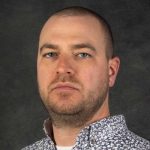By Allison Campbell-Jensen
As he created his sound art installation “Hydrophonics,” Nicholas Bauch consulted with a number of people around the University of Minnesota Twin Cities. Among them were Benjamin Wiggins, Alexis Logsdon, and Ryan Mattke from the Libraries.
“I wouldn’t have been able to put this together in a summer without having access to the materials and knowledge of the Libraries and CLA,” says Bauch, who is a 2021 Human in the Data Fellow (fellowship funding is from Research Computing) and graduates from the Master of Fine Art program in September.
Concern for water
Bauch is interested in the potential for physicality of data. Entering into the “Hydrophonics” sound art installation, one sees bottles of water labeled for six lakes, six sets of photographs, a book on display, and six music stands holding sheets with lake outlines on one side and overlapping lines on another. A lake surface in tight close-up waves gently in a video projected on a wall; a laptop, sound equipment, and a waterphone percussion instrument await.
The abundance of fresh water in Minnesota is one of the things that struck Bauch upon returning to the state as an adult from the arid West. Water is not only part of the Land of 10,000 Lakes nickname, it’s expected and relied upon.
“It’s not this immediate pressing thing that is actually affecting people’s lives and livelihoods today,” Bauch says, unlike in the West. There is infrastructure in the West to move the precious, dwindling water and to him it does not seem like a leap that some would envision those infrastructures could come east to where all this water is, in the Great Lakes region, to obtain more.
Converting data into sound
Bauch has a geography background that he brings to his creative work. To create “Hydophonics,” he had help from U-Spatial Research Assistant Brian Coan to move Geographic Information System data — ”shape files,” as they are known — for all the lakes in Minnesota into Adobe Illustrator.
“It was the building out of GIS datasets of Minnesota lakes in clearly a contorted, artistically manipulated way,” he says. With this data, he created the scores from which he plays.
Wiggins, Director of the Digital Arts, Sciences & Humanities program that is one of the sponsors of the Human in the Data fellowships, introduced Bauch to School of Music faculty and staff to obtain some of the equipment. Bauch had to purchase the waterphone himself.
Mattke located “An Inventory of Minnesota Lakes” for Bauch’s installation. He and his team also facilitated the aerial photographs that Bauch used. Because of the way that aerial photos were taken in the late 1930s, “the pictures overlap, which gives them their stereoscopic potential,” Bauch says. In each set of four, he juxtaposed three black-and-white images of a lake, with a contemporary color photo of Hoover Dam that he took.
Bauch activates the installation space by entering, picking up the waterphone and a bow, and “playing” the voice of the lake chosen by an audience member. Sparked from data, something new springs to life.
‘Hydrophonics’ on SoundCloud





